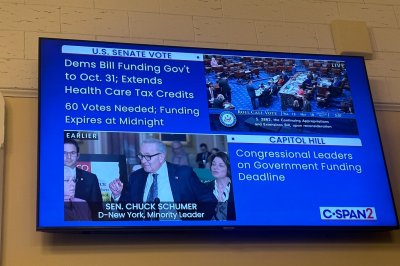
C-SPAN televised on Capitol Hill shows the U.S. Senate vote ahead government shutdown in Washington on Tuesday. Photo by Bridget Erin Craig/UPI
WASHINGTON, Sept. 30 (UPI) — The federal government shutdown leaves thousands of federal workers without pay, and an array of public facilities, such as Smithsonian museums and national parks, cite the challenges staying open without much staff.
Smithsonian museums announced on their combined website they have funding set aside to stay open until Oct. 6. The situation with national parks, though, is up in the air. If they don’t close, visitors would not have adequate protection without adequate staffing.
The Library of Congress, another symbol of Washington, announced it will lock its doors to visitors and cancel all events.
Moreover, congressional offices said, the National Institutes of Health will be unable to see new patients to its research hospital, and the Food and Drug Administration will be unable to process applications for new drugs or medical devices.
For those who lived through past shutdowns — the last one came during the first Trump administration in December 2018 and lasted 34 days — the fallout is all too familiar.
David Barna, who served as chief spokesman for the National Park Service from 1995 to 2015, worked during the 34-day shutdown in 2018 and recalled its emotional toll. With roughly 1 million visits to national parks each day, he said closures are “devastating to our visitors.”
“It was heartbreaking for our park visitors,” Barna said. “People who had waited years to visit parks had their plans canceled. I remember talking with a young woman who planned to get married in Yellowstone, and she cried on the phone as she told me about canceling her wedding.”
This time, Barna warned, the situation is likely to be worse. “Rumor is that the parks will be open without staff,” he said. “Last time this happened, the parks were vandalized and trash accumulated everywhere. We need NPS employees to take care of the natural and cultural resources in the parks.”
He added, “Without staff, they are unprotected. The parks are gifts from our grandparents to our grandchildren. Our job is the preserve and protect them,” he said.
Just as Barna fears national treasures will go unprotected without park staff, union leaders representing VA employees warn that the shutdown threatens the people caring for the nation’s veterans.
Robert Malosh, president of a local chapter of the American Federation of Government Employees, said his members fear that a prolonged gridlock will be used to justify further cuts to staff who provide critical care to veterans.
“Since this administration appears to be hell bent on eliminating staff at all costs, there’s plenty of fear that this administration will abuse these emergency powers to further wage war against the heroes who provide care to our veterans,” Malosh said.
“As we speak, some of the best and most qualified personnel are looking for jobs to replace the stability and security they’ve lost in the last eight months,” he said.
While many other federal employees anticipated the shutdown, staffers were already preparing for what has become the reality — working without pay. A spokesperson for Rep. Mike Quigley, D-Ill., said House employees have been declared essential and will report to work regardless of whether funding lapses.
“That means we will be working unpaid for the duration of a shutdown,” the spokesperson said, noting that House staff members are paid on the 30th of each month, providing a brief cushion before the paycheck gap becomes real.
In the 2018 government shutdown, 800,000 federal workers were furloughed and cost the U.S. economy an estimated $11 billion. It was the longest of the 20 shutdowns throughout history, occurring during the first Trump administration.
Each time, political stalemates in Congress continue to leave federal workers, service members and the public caught in the middle.
Uncertainty has also hit the National Guard deployed in Washington. The D.C. National Guard State Public Affairs Office told UPI it had no information on whether troops will continue their deployment or if they will be paid, referring questions to the White House.
That ambiguity underscores how even roles deemed essential by the Trump administration are clouded during a funding lapse.
From Hill staffers to the thousands of others across Washington, the question is how long they can go unpaid. For tourists, consumers, veterans and patients across the country, it remains to be seen what remains open and for how long should the shutdown persist.